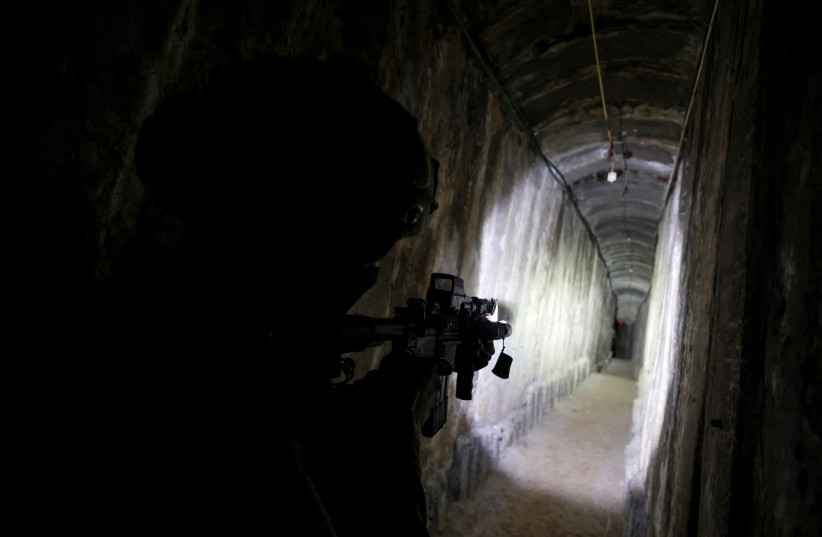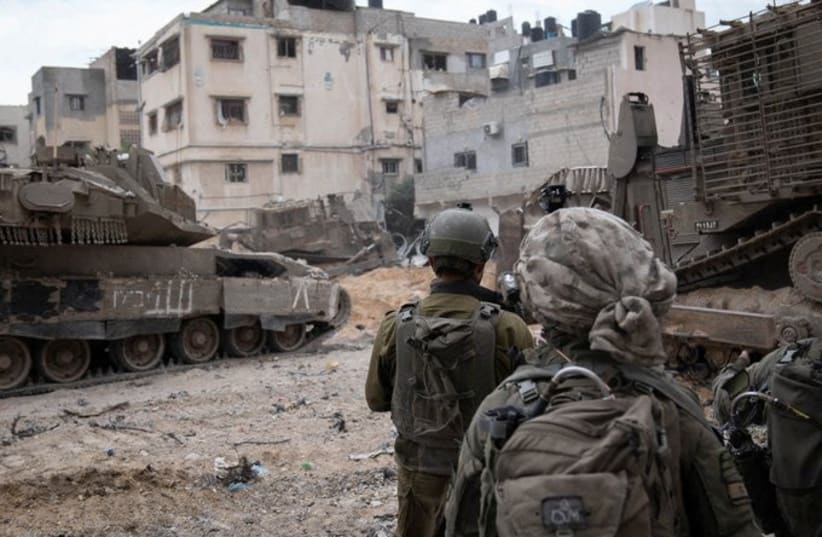About four kilometers from Nir Oz, into the Gaza Strip, lies the Palestinian town of Khirbet Khuza’a in the Khan Yunis governorate.
Gilad, a battalion commander in the Fifth Infantry Brigade, explains that “it is from there that the terrorists set out on October 7. We need to be the ones to go there. We planted the flag of Nir Oz on the municipal building there. Our mission is to create a buffer zone so that the residents can return home.”
Khirbet Khuza’a is the 5th Infantry’s current center of operations. The brigade, a reserve formation, traces its history back to the Givati Brigade in the 1948 war.
Reporting from Gaza
Gilad, a major in the reserves and a corporate lawyer in civilian life, was mobilized on October 7, along with the rest of the brigade.
“We came down to the border area on October 8; it looked like a battlefield. During the first week, we were helping to clear up – whatever was needed, even surreal activities like milking cows. Then, after one and a half weeks, we joined the brigade in defense from Nahal Oz to Re’im. We then went into Beit Hanun, after the ceasefire, for two weeks, to create the buffer zone there, and now we’re doing the same thing in Khuza’a.”

The ride from Nir Oz to Khuza’a on Wednesday was short. The kibbutz was one of the hardest hit on October 7, with 46 of its 400 residents murdered and another 71 taken hostage. People from Khirbet Khuza’a followed the Hamas men on the day of the massacre, took part in the looting, and worse. “We’re closing the circle,” Gilad tells me.
Inside Khirbet Khuza’a, the tempo of operations is notably different from what I witnessed in Shejaia further north just a few weeks ago. When we moved, it was only locked down in APCs. In Khuza’a, the pace is more deliberate. The 5th brigade established its area of control, and is methodically destroying the ‘terror infrastructure,’ both inside the houses and beneath them, infrastructure that is tightly woven into the fabric of civilian life.
The brigade has found weapons consignments in both schools and homes. The tunnels are the main issue; it is painstaking work to dismantle them – locating the shafts under the ever-present threat of contact with Hamas gunmen.
Shai, a company commander in the Brigade, described a reality of constant psychological tension for the infantry soldiers operating in the forward units, across the eerie, ruined urban landscape of southern Gaza: “We see writing on the walls in Hebrew, and body parts strewn about. You see someone 200 meters in front of you, and you don’t know if it’s a civilian or a trap. The danger is all around you, nowhere is safe. So we’ve had to learn to think differently. We’re used to the situation of ‘We’ve been fired on – charge forward’, but here it is different. They study, and learn, and here we can be fired on from 360 degrees around us. It’s a change we need to internalize.
“It’s exhausting work,” he continued. “For the first hour, you are primed and ready; for the second hour, you’re already exhausted. You have to find ways to keep your motivation. You are exhausted, but you understand the importance of the mission. And of course, we know that we could be in uniform again in two or three months, given the situation in the North.”
The 5th Brigade’s commander, Col. Tal Koritzky, explained that in “every second house here, we find weapons, we also come across looted items from the Kibbutz, children’s toys and other personal items.” Koritzky, a moshavnik from western Galilee, is one of the few regular soldiers in this brigade of reservists.
Koritzky spoke from one of the ruined houses of Khirbet Khuza’a; gunfire sounded a few hundred meters away.
One of the battalions engaged in a clash with Hamas fighters in the area, and all under the presence and threat of the tunnels, the main mission.
“Our mission is clear. I’m a fighter, not a politician. We’re here with each other, from all over the country, from all kinds of different backgrounds, ‘Am Yisrael’ at its best,” said Koritzky.
Shai, the company commander, said as we left that it is “worth remembering that if we won’t go in, no one will. There isn’t another IDF to take over.”
On the short journey back to Nir Oz, the southern Gaza mission crystallized for me: through a gaping hole, I could see the border fence from October 7. “We are here from the first second, and we will be here until the last so that life for the residents in the Gaza border communities can return as much as possible to how it was before.”
This is how the war in southern Gaza is: Slow, exhausting, Sisyphean work, gradually clearing out the Hamas structures to create a buffer zone along the border.
Further missions deeper into Khan Yunis lie ahead, but the destruction of Hamas governance in Gaza, as seen from the ground, appears to be proceeding steadily apace.
